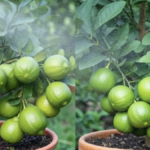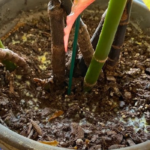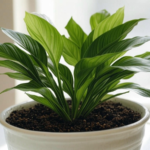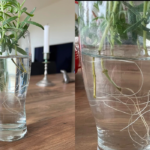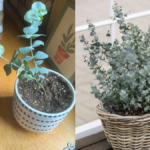Want to grow a healthy mint plant at home? Learn How to Take Care of Mint Plant and grow it from seeds, trim it the right way, and even grow it indoors. Perfect for beginners and home gardeners!
As someone who’s been growing mint (pudina) for the last few years in my balcony garden, I can tell you— mint is one of the most satisfying herbs to grow at home. It grows fast, smells amazing, and adds instant freshness to your food and drinks. In this guide, I’ll share everything I’ve learned.
Table of Contents
How to Take Care of Mint Plant
Mint is not fussy, but like any other plant, it has its likes and dislikes. To help your mint plant grow bushy and healthy, make sure to take care of the basics:
Watering: Keep the soil consistently moist but not soggy.
Soil: Use well-draining, slightly acidic to neutral soil.
Sunlight: Prefers partial shade to full sun (4-6 hours of sunlight).
Container: Use a wide pot to prevent spreading.
Fertilizer: Use a balanced liquid fertilizer once a month.
Watering Your Mint Plant
Watering is one of the most important parts of mint care.
Here’s what works best:
- Water your mint plant once the top 1 inch of soil feels dry.
- In hot weather, you might need to water it daily or every alternate day.
- If the plant is indoors, water it 2–3 times a week, depending on humidity.
- Never let the soil dry out completely—mint loves moisture but hates soggy roots.
Sunlight Needs for Mint
Mint is flexible with light, but it grows best with the right amount.
Sunlight tips:
- Mint needs 4–6 hours of sunlight daily.
- If you’re growing indoors, keep it near a south- or west-facing window.
- If outdoor sun is too harsh, go for partial shade—mint does well in filtered light too.
Ideal Temperature for Mint Plant
Mint loves moderate weather and grows well in Indian climates.
Temperature range:
- 18°C to 30°C (65°F to 85°F) is perfect for mint.
- It can tolerate slightly higher temperatures but may wilt in extreme heat.
- During winter, bring indoor plants near a window for warmth and light.

Best Fertilizer for Mint Plant
Mint doesn’t demand much when it comes to fertilizers, but a little feed boosts its growth.
Fertilizer tips:
- Use a balanced liquid fertilizer (10-10-10) once a month.
- Organic compost or vermicompost also works great for mint.
- Avoid over-fertilizing—too much can affect the flavor and aroma of the leaves.
How to Grow Mint from Seed
Starting mint from seed is a slow but rewarding process.
Steps to grow mint from seeds:
- Fill a seed tray or small pots with seed-starting mix.
- Sprinkle the seeds and press them lightly (don’t bury them deep).
- Mist the surface with water and cover it with plastic wrap.
- Keep it in a warm, bright spot.
- Seeds will germinate in 10–15 days.
- Transplant them once they’re 2–3 inches tall.
Growing Mint Indoors
Growing mint indoors is perfect for small spaces and apartments.
Indoor care tips:
- Use a pot with drainage and place it on a sunny windowsill.
- Rotate the pot every few days to encourage even growth.
- Avoid overwatering—check the soil before watering.
- Trim it often to keep the plant compact and healthy.
How to Trim a Mint Plant
Trimming mint regularly encourages bushy growth and prevents flowering.
Trimming guide:
- Trim once the plant is 4–5 inches tall.
- Use clean scissors to cut just above a set of leaves.
- Don’t trim more than 1/3 of the plant at once.
- Trim every 2–3 weeks during the growing season.
How to Cut Mint from Plant
Harvesting mint is super easy.
Here’s how:
- Choose fresh, green stems.
- Cut just above a leaf node to encourage side shoots.
- Harvest in the morning for the best aroma.
- Always use clean scissors or shears.
Can You Plant Mint and Basil Together?
Yes, you can—but there are a few things to keep in mind.
Important points:
- Mint is aggressive and can take over the pot.
- Basil prefers drier soil than mint.
- Use a large pot with a divider, or separate pots for best results.
- Prune both regularly to keep them under control.
Common Mint Plant Problems and Fixes
| Problem | Reason | Solution |
|---|---|---|
| Yellow leaves | Overwatering | Let soil dry slightly before watering |
| Wilting | Underwatering or root rot | Check moisture level and drainage |
| Slow growth | Lack of sunlight or nutrients | Move to sunnier spot, fertilize monthly |
| Leaf holes | Pests like aphids | Spray neem oil or soapy water |
| Powdery leaves | Fungal infection | Improve air flow, remove infected leaves |
How long does it take mint seeds to grow?
Mint seeds usually take 10–15 days to germinate. After that, it takes 6–8 weeks to grow into a transplant-ready plant. Be patient—mint is slow from seed but worth it
Can I grow mint indoors all year round?
yes, Mint can be grown indoors year-round if it gets enough light and stays in a moderate temperature range (18–30°C). Just keep it near a bright window and water it regularly
Q2. Does mint need full sun or shade?
Mint grows best with 4–6 hours of sunlight. It can handle both full sun and partial shade. If growing indoors, place it near a sunny window for best results.
Final Thoughts:
Mint is truly a beginner-friendly plant that brings freshness to your kitchen and garden. With just a little care—proper watering, sunlight, temperature, and trimming—you can enjoy homegrown mint all year round. Whether growing from seed or in a pot indoors, this humble herb is a green reward for your efforts
Read more post
Best Basil Plant Care Tips for Beginners – Grow Healthy & Bushy Basil
ZZ Plant Care Guide – Real Tips from My Gardening Experience

